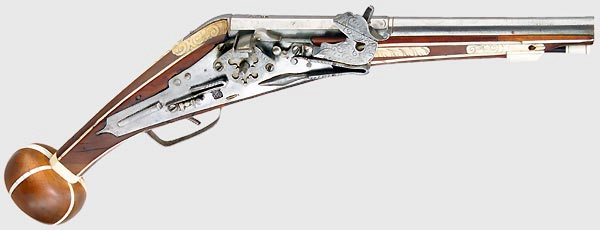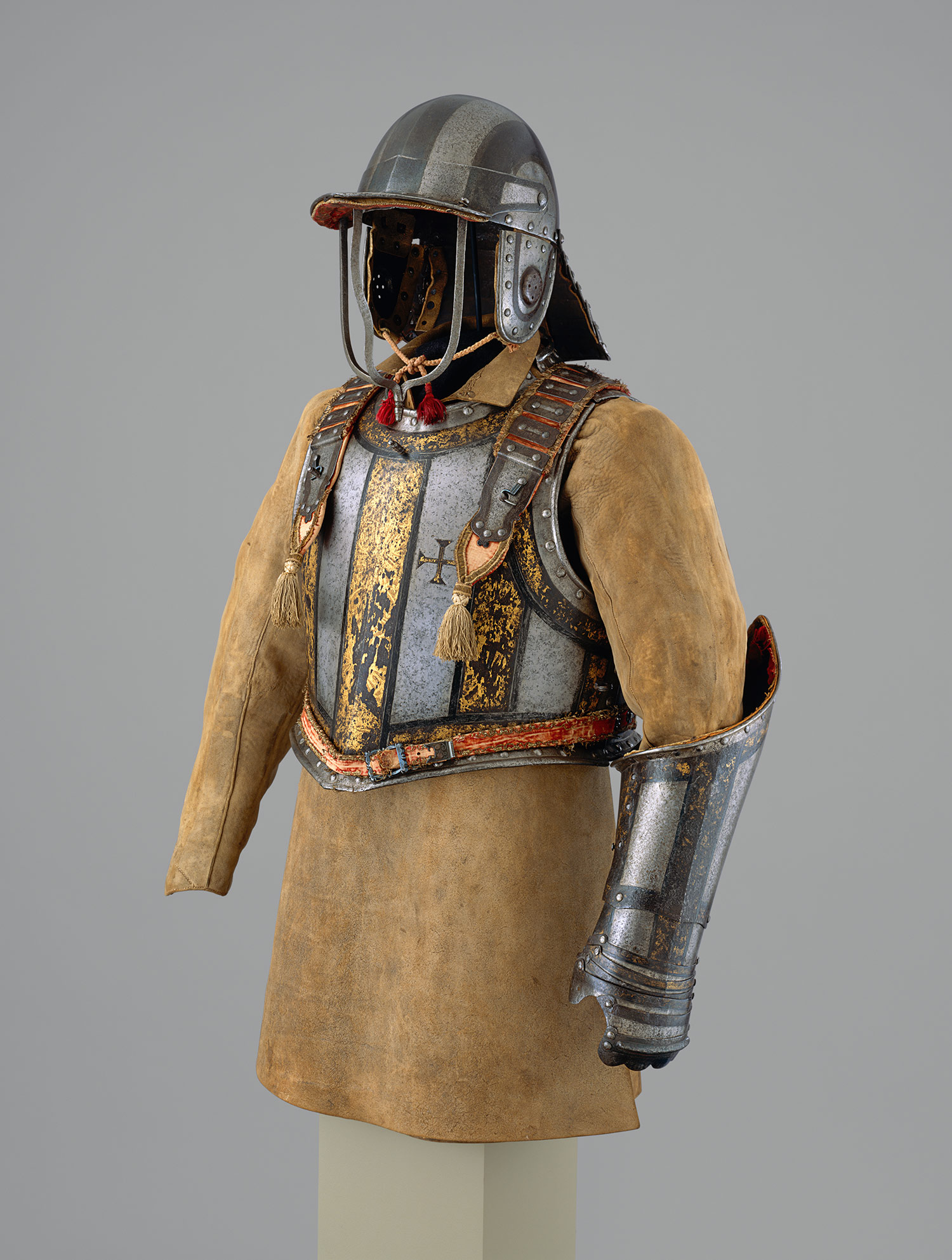Pat
Administrator

Posts : 458
Join date : 2012-02-04
 |  Subject: Common arms and armament of the New Age. Subject: Common arms and armament of the New Age.  Wed Feb 22, 2012 11:36 am Wed Feb 22, 2012 11:36 am | |
| ___________________________________________________________
Originally for Aeria by Rutabega.
___________________________________________________________ The ArquebusDespite being a relatively new addition to armories across Aeria the arquebus has drastically changed the face of warfare and the very nature of fighting it's self. The arquebus is, in short, a long metal tube packed with a lead shot and a mix of chemical propellants used to fire the round at a very high velocity. The origins of the modern version of the arquebus remains quite muddled, with some accounts claiming that they arrived from the far east beyond the deserts of Sida, while others claim that the first true arquebus was of Occitanian design after the introduction of black powder from the east. Regardless of where it came from the arquebus began to see use all over Aeria, becoming as prominent in war as the sword of shield of old in the space of a few decades. The weapon was prized by nobles for it's pick up and fire style and relatively low production cost. However, one large setback that the early arquebus using nations found was that nobody had even the most vague idea of how to most effectively make use of such a weapon in war. In it's early few years of use many commanders treated it like a crossbow, using it for initial barrages and long ranged support which proved to be less then optimal considering the arquebus' relatively poor accuracy over a distance coupled with a long reload time. Despite being initially introduced to supplement traditional means of warfare it's continued use soon brought about the very opposite as other forms of arms and armor began to evolve to suit the needs of the ever popular arquebus. Currently commanders use the arquebus with medium foot soldiers often clad in buff coats and breastplates either en masse with several ranks firing volleyed rounds with medium of heavy infantry in proximity, or in smaller squads where individuals fire in succession while keeping their squadmates under cover. The arquebus has also found significant use amongst the civilian population, where it's lowered accuracy and single shot are negated by it's hard hitting power at closer ranges (even lighter versions being known as a caliver which can be viewed as a carbine of sorts). It is also worth noting that the vast majority of both civilian and military arquebuses and muskets use what is known as a 'matchlock' mechanism, which is a slow burning chord gripped by the firing hammer, meaning that before even firing the gun is possible a lit chord must be ready. The other, far rarer mechanism is known as 'wheel lock' which, at it's simplest is a spring powered steel wheel which grinds against a held bit of pyrite to draw a spark which ignites the powder. However, the actual workings of the wheellock are far more complex and as such makes them not only incredibly expensive but also very finicky, requiring hours of weekly (if not daily) maintenance to keep the entire process from jamming. Arquebus rifle and pistol with wheellock mechanisms  - Spoiler:
Arquebus with a more common matchlock mechanism. Internal components of the wheellock mechanism. Internal components of the wheellock mechanism.
MusketThe musket is literally a larger, harder hitting, longer raged big brother to the arquebus. With the development of the arquebus soldiers began using increasingly heavy armors in an attempt to render the arquebus harmless. This brought about the use of the musket with it's higher penetration, larger caliber round and increased accuracy. The downside to this was of course a limited mobility which rendered the musket too heavy to be fired by a normal human without the use of a firing stick (or some other sort of stand, be it natural or artificial). However, as the musket saw wider use commanders began to outfit their soldiers with lighter armor, realizing that they would need to make armor so heavy that it would be impractical to move in battle. With this the arquebus became much more wide spread, though some units, especially cavalry would remain heavily armored keeping the need for a harder hitting firearm. More often then not musketeers are lightly armored, if at all, preferring to use their vastly superior range to act as sharpshooters of sorts and only drawing closer when an exceptionally heavily armored opponent comes to face them.  Swords and melee weapons Swords and melee weaponsDue to armor having grown lighter and the increasing rarity of full plate armor swords have become far more widespread. In addition, with the decreased use of shields (now rendered obsolete unless constructed of thick, heavy metal) most swords are found with a basket guard over the hilt which encompasses the wielder's hand, allowing the sword it's self to act as a rudimentary shield if the need is great enough. These are often broadswords, favored by both cavalry and footmen for their decent reach and weight, while other lighter stabbing blades known as rapiers exist primarily amongst the civilian class who are prone to being without armor. However, also thanks to the decreased usage of shields many longer reach weapons are favored amongst most footmen. Examples of these include the halberd, which is also used against mounted opponents, bardiches (long shafted, long bladed battle axes) and hefty, two handed swords such as claymores. - Spoiler:
Typical basket hilted sword. Bardiche. Bardiche. Rapier. Rapier.
| |
|
Pat
Administrator

Posts : 458
Join date : 2012-02-04
 |  Subject: Re: Common arms and armament of the New Age. Subject: Re: Common arms and armament of the New Age.  Wed Feb 22, 2012 11:36 am Wed Feb 22, 2012 11:36 am | |
| Buff CoatThe buff coat is one of the cheapest and most common types of protection found in both civilian and military use. All buff coats are made from thick strips of suede cow leather, offering minor protection against slashes, blunt force and even longer ranged pistol shots. However the buff coat by it's self should by no means be considered effective enough to stop any proper attack and, as such is often used under heavier bits of armor such as breastplates. The coat has also become very popular amongst the civilian population as a presentable style of attire amongst the middle and upper classes. The buff coat is also popular amongst mages who will often enchant the buffcoat to increase it's usefulness against damage.  "Half-Armor" "Half-Armor"Half-armor is a umbrella term applied to a wide range of predominantly infantry orientated armor that is intended to protect the upper half of a soldier's body. The style and composition of half-armors vary wildly but a common factor is their low cost and relative low quality (when compared to the heavier cavalry armor) which allows them to be mass produced for the ranks, though they're also easily obtained to civilians and private paramilitary forces. Despite being made of iron rather then steel most half-armors provide decent enough protection from arquebuses at longer ranges, though the shots often dent the armor enough to crack ribs. Several different styles of half-armor. - Spoiler:
Heavy armorA few types of fullbody plate do exist to the modern day, their continued use being thanks to increased thickness of the frontal plates, giving the wearer decent overall protection against everything short of a musket shot at closer ranges. However these types of armor find themselves in dwindling use, now primarily only popular with noblemen, commanders and heavy cavalry, since the increased weight renders them impractical to use on foot. This in addition with their increased cost has made them somewhat of a rarity, especially amongst the civilian population where mobility and cost effectiveness tend to be preferred.  Weave armor Weave armorWeave armor is any type of armor that has been imbued with any sort of enchantment to increase it's toughness (mainly against firearms). This is often achieved by creating an inlay of gold or some other magically reactive metal. The effectiveness of this method varies wildly however, depending on the enchanter, the quality of the metal and how often the piece of armor in question is used. This, in addition to the extravagant cost means that most forms of weave armor is seldom used, with buyers often being cheated by second rate mages into paying for a shoddy piece of equipment. A weaved breastplate with golden inlay in conjunction with a buff coat and helmet.  | |
|
Rutabega
Administrator

Posts : 201
Join date : 2012-02-20
 |  Subject: Re: Common arms and armament of the New Age. Subject: Re: Common arms and armament of the New Age.  Tue Aug 28, 2012 11:23 am Tue Aug 28, 2012 11:23 am | |
| Forgotten from old forums. Motile ArquebusThe motile arquebus (sometimes refered to as the Tempest Shot) is a specially designed firearm meant for the exclusive use of special motile shots which provide and sudden jolt of non lethal electricity unto a target. The motile arquebus is very similar to any run of the mil firearm until one takes a look at it's barrel. The interior of a motile firearm is covered in a grainy, abrasive finish which is designed to create friction with the motile shot as it exits the barrel in order to charge the bullet. However, because of this sandy surface the velocity of the shot is significantly lower to traditional smoothbore gun. This, in addition to the soft, fragile nature of motile makes the motile arquebus a non lethal weapon. only being able to penetrate the skin with a near point blank shot. Furthermore the barrel of the Tempest shot often needs to be replaced as constant wear and tear on the grainy interior of the barrel will wear it down over time. The Tempest shot is a favored weapon of law enforcement groups who often use it for non lethal take downs. One final note is upwards of ninety-five percent of all motile arquebuses are in a carbine form, as the longer barrel of the arquebus (or musket) wouldn't add enough to it's penetration or velocity to be worth the extra time and resources.  - Spoiler:
| |
|
Sponsored content
 |  Subject: Re: Common arms and armament of the New Age. Subject: Re: Common arms and armament of the New Age.  | |
| |
|




